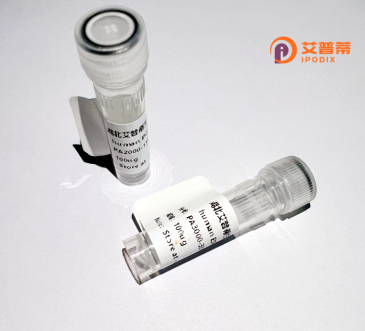
| 纯度 | >90%SDS-PAGE. |
| 种属 | Human |
| 靶点 | ATE1 |
| Uniprot No | O95260 |
| 内毒素 | < 0.01EU/μg |
| 表达宿主 | E.coli |
| 表达区间 | 1-518aa |
| 氨基酸序列 | MAFWAGGSPSVVDYFPSEDFYRCGYCKNESGSRSNGMWAHSMTVQDYQDLIDRGWRRSGKYVYKPVMNQTCCPQYTIRCRPLQFQPSKSHKKVLKKMLKFLAKGEVPKGSCEDEPMDSTMDDAVAGDFALINKLDIQCDLKTLSDDIKESLESEGKNSKKEEPQELLQSQDFVGEKLGSGEPSHSVKVHTVPKPGKGADLSKPPCRKAKEIRKERKRLKLMQQNPAGELEGFQAQGHPPSLFPPKAKSNQPKSLEDLIFESLPENASHKLEVRLVPVSFEDPEFKSSFSQSFSLYVKYQVAIHQDPPDECGKTEFTRFLCSSPLEAETPPNGPDCGYGSFHQQYWLDGKIIAVGVIDILPNCVSSVYLYYDPDYSFLSLGVYSALREIAFTRQLHEKTSQLSYYYMGFYIHSCPKMKYKGQYRPSDLLCPETYVWVPIEQCLPSLENSKYCRFNQDPEAVDEDRSTEPDRLQVFHKRAIMPYGVYKKQQKDPSEEAAVLQYASLVGQKCSERMLLFRN |
| 分子量 | 83.38 kDa |
| 蛋白标签 | GST-tag at N-terminal |
| 缓冲液 | 冻干粉 |
| 稳定性 & 储存条件 | Lyophilized protein should be stored at ≤ -20°C, stable for one year after receipt. Reconstituted protein solution can be stored at 2-8°C for 2-7 days. Aliquots of reconstituted samples are stable at ≤ -20°C for 3 months. |
| 复溶 | Always centrifuge tubes before opening.Do not mix by vortex or pipetting. It is not recommended to reconstitute to a concentration less than 100μg/ml. Dissolve the lyophilized protein in distilled water. Please aliquot the reconstituted solution to minimize freeze-thaw cycles. |
以下是关于重组人精氨酰-tRNA-蛋白质转移酶1(ATE1)的3篇代表性文献及其摘要简述:
---
1. **文献名称**:*Arginyltransferase ATE1 is a modulator of epithelial-mesenchymal transition in carcinoma cells*
**作者**:Kwon YT et al.
**摘要**:本研究揭示了ATE1通过精氨酰化修饰靶蛋白(如β-肌动蛋白),调控上皮-间充质转化(EMT),影响癌细胞的迁移和侵袭能力。ATE1缺失导致细胞骨架重组受阻,从而抑制肿瘤转移。
---
2. **文献名称**:*Hypoxia regulates post-translational protein modification by inhibiting the activity of arginyltransferase ATE1*
**作者**:Hu RG et al.
**摘要**:研究发现,低氧条件通过抑制ATE1酶活性,减少靶蛋白(如HIF-1α)的精氨酰化修饰,从而调控细胞对缺氧的适应性反应,影响血管生成和肿瘤微环境。
---
3. **文献名称**:*ATE1-mediated arginylation is essential for cardiovascular development*
**作者**:Kurosaka S et al.
**摘要**:通过构建ATE1基因敲除小鼠模型,发现ATE1缺失导致胚胎期心血管系统发育异常,提示精氨酰化修饰在血管生成和心脏功能中起关键作用。
---
这些研究分别从癌症生物学、缺氧应激调控和发育生物学角度阐述了ATE1的功能。如需具体文献,建议通过PubMed或期刊官网输入标题查询全文。
Arginyl-tRNA-protein transferase 1 (ATE1) is an evolutionarily conserved enzyme that catalyzes post-translational arginylation, a process critical for protein homeostasis. It transfers arginine from arginyl-tRNA to specific acceptor proteins, typically targeting destabilizing N-terminal residues (e.g., Asp, Glu) or internal acidic residues. This modification regulates protein stability by creating degradation signals recognized by the ubiquitin-proteasome system.
ATE1 plays diverse roles in cellular processes, including stress response, cytoskeletal organization, and cardiovascular development. Studies in model organisms reveal its involvement in angiogenesis, cardiac contractility, and neural function. Mammalian ATE1 exists as multiple splice isoforms with distinct subcellular localization patterns and substrate preferences, suggesting functional specialization.
Notably, ATE1 activity is modulated by environmental cues such as hypoxia and oxidative stress, interacting with pathways like HIF-1α and NF-κB. Dysregulation of arginylation links to pathological conditions, including cancer metastasis, cardiovascular diseases, and neurodegeneration. ATE1 knockout models demonstrate embryonic lethality in mice and developmental defects in lower eukaryotes, underscoring its biological essentiality. Recent structural studies have begun elucidating its catalytic mechanism, though the full spectrum of physiological substrates remains under exploration.
×